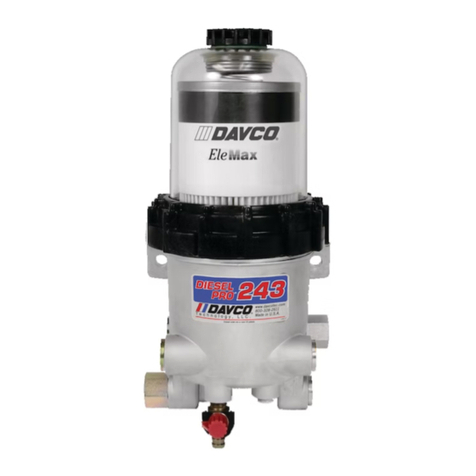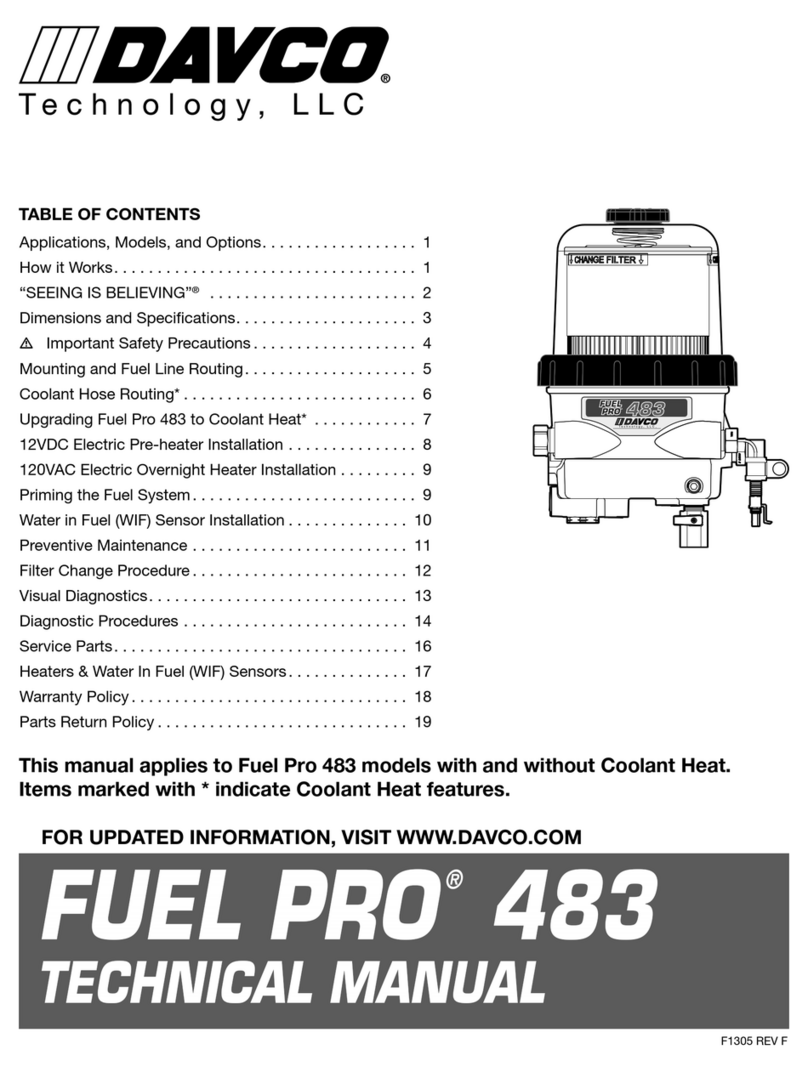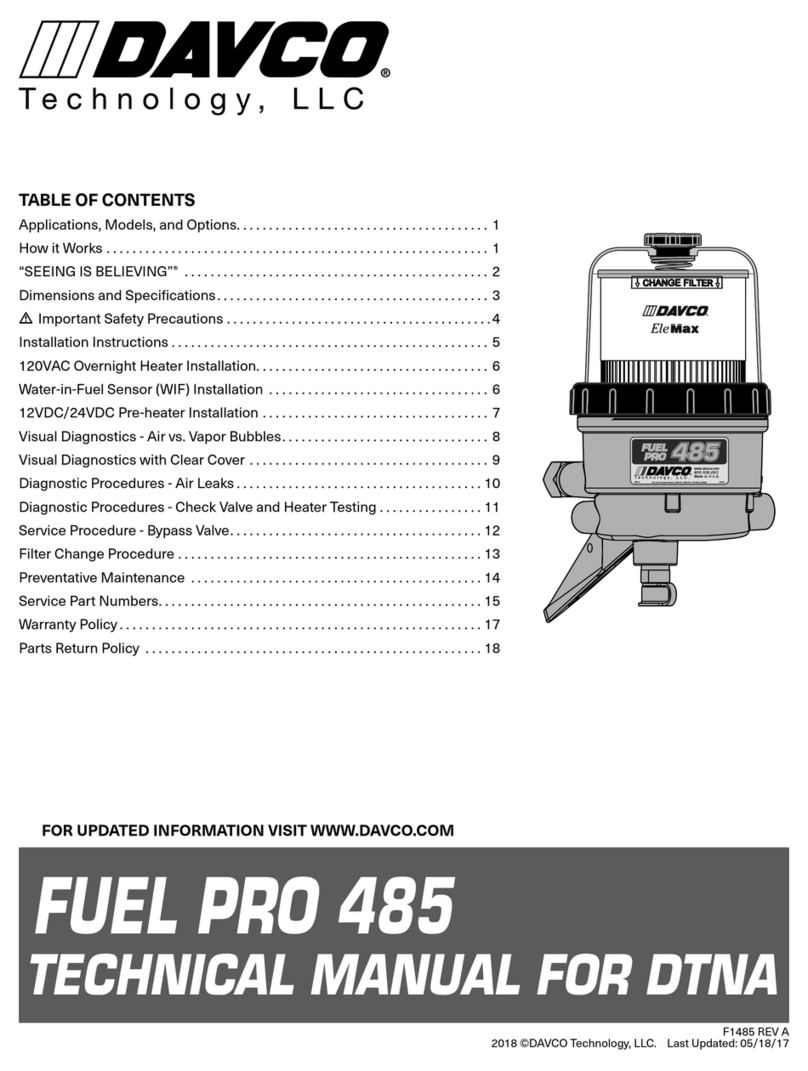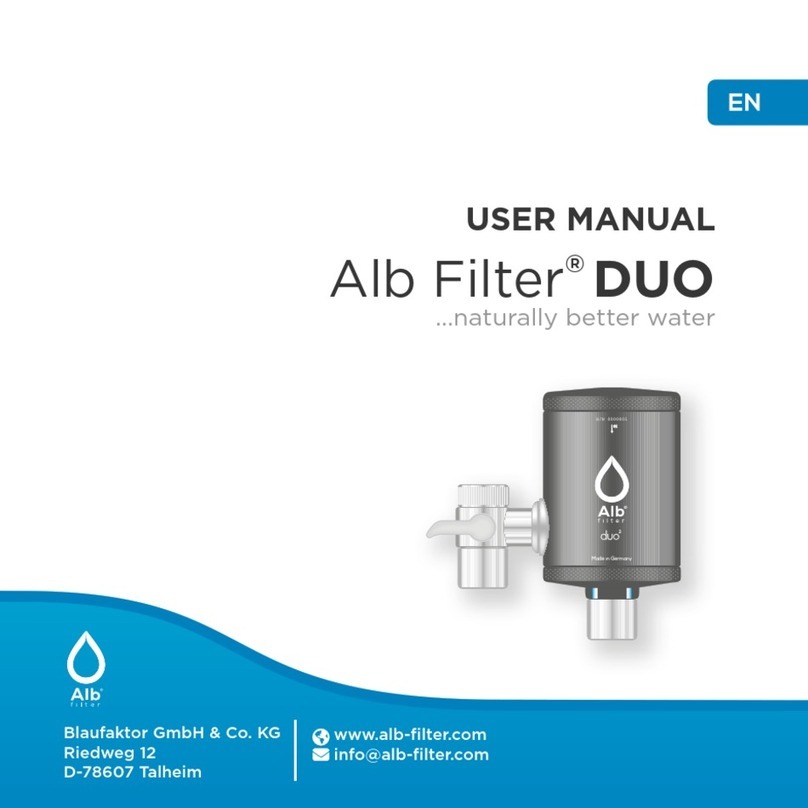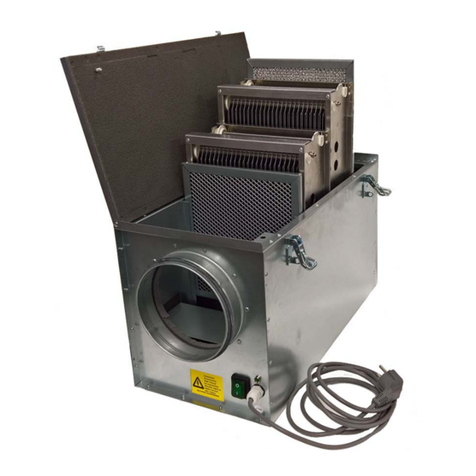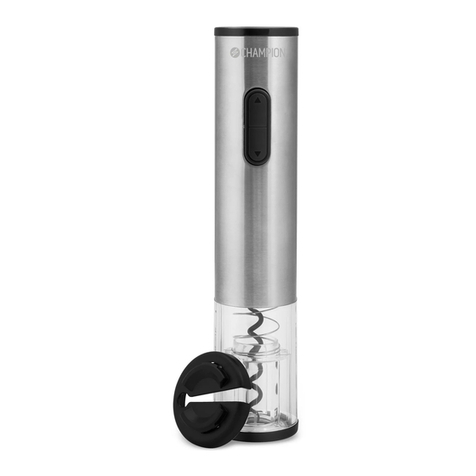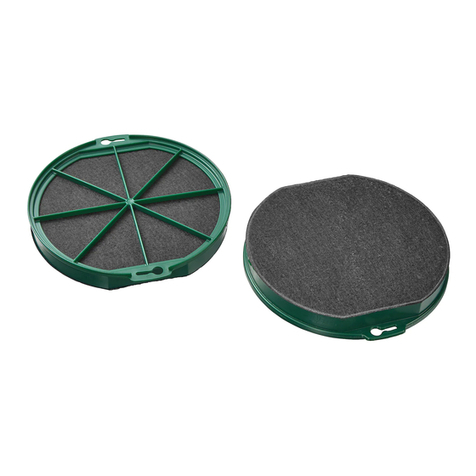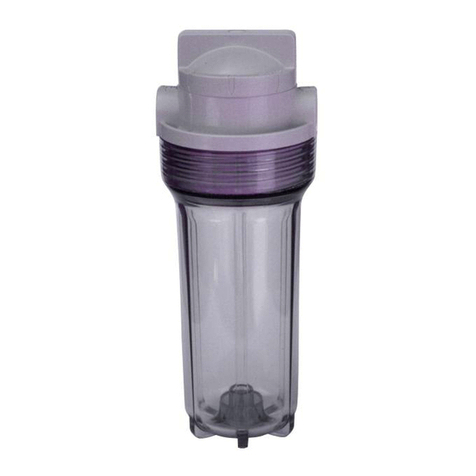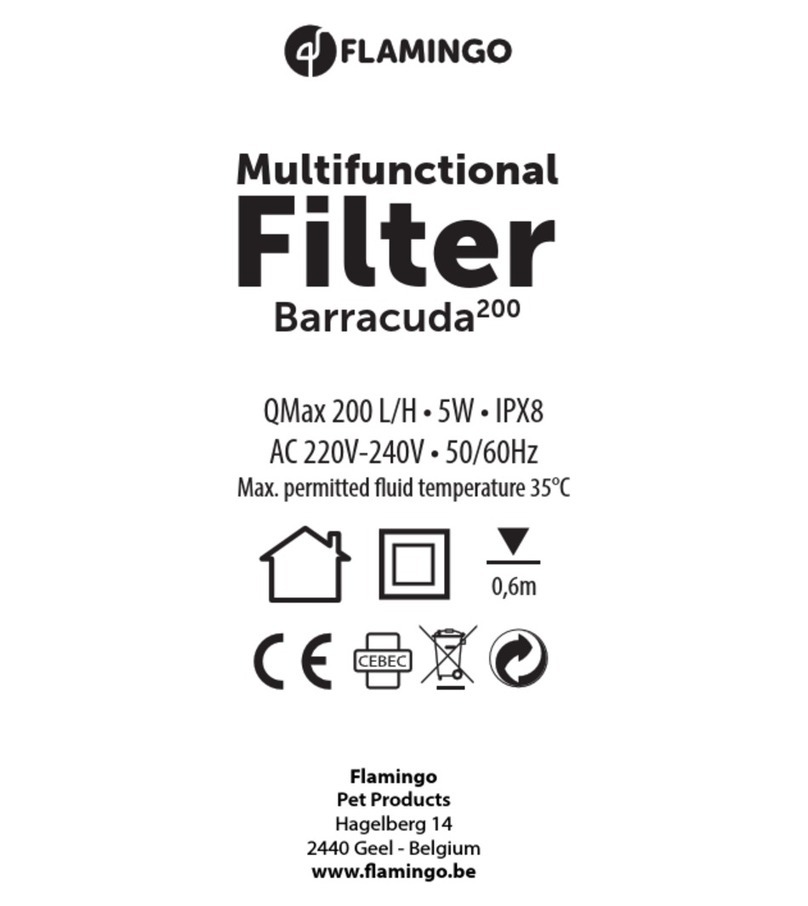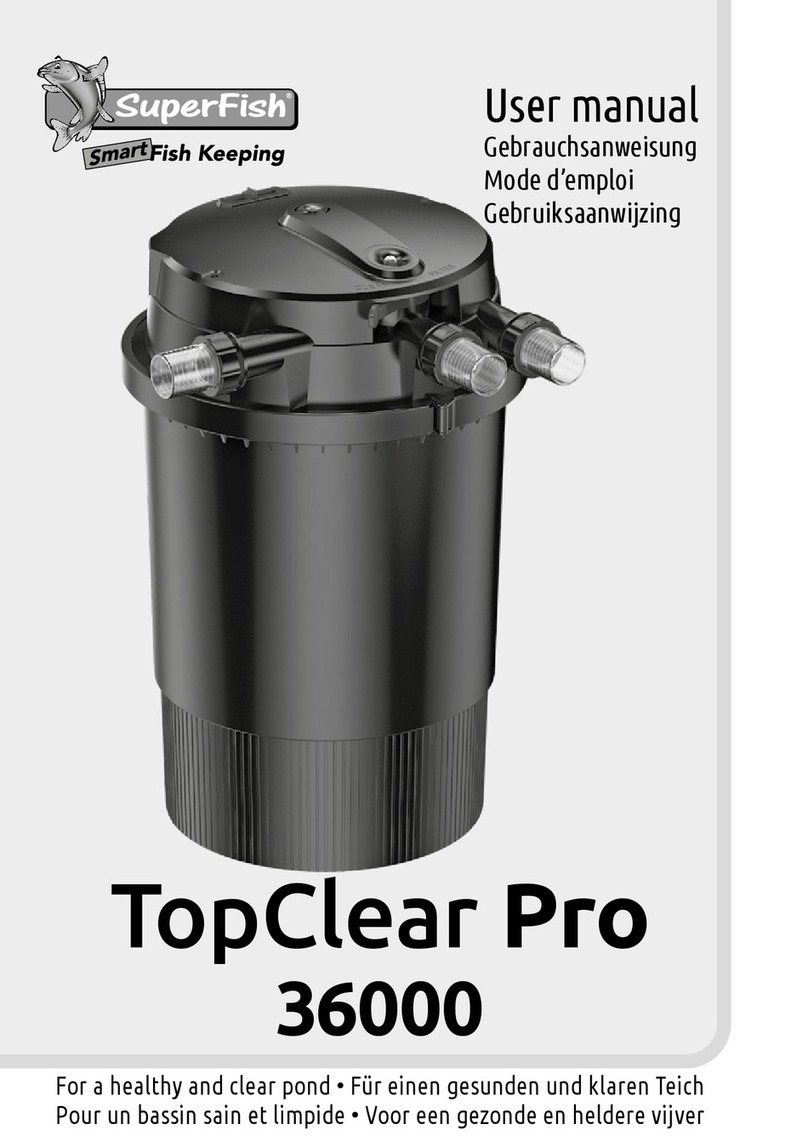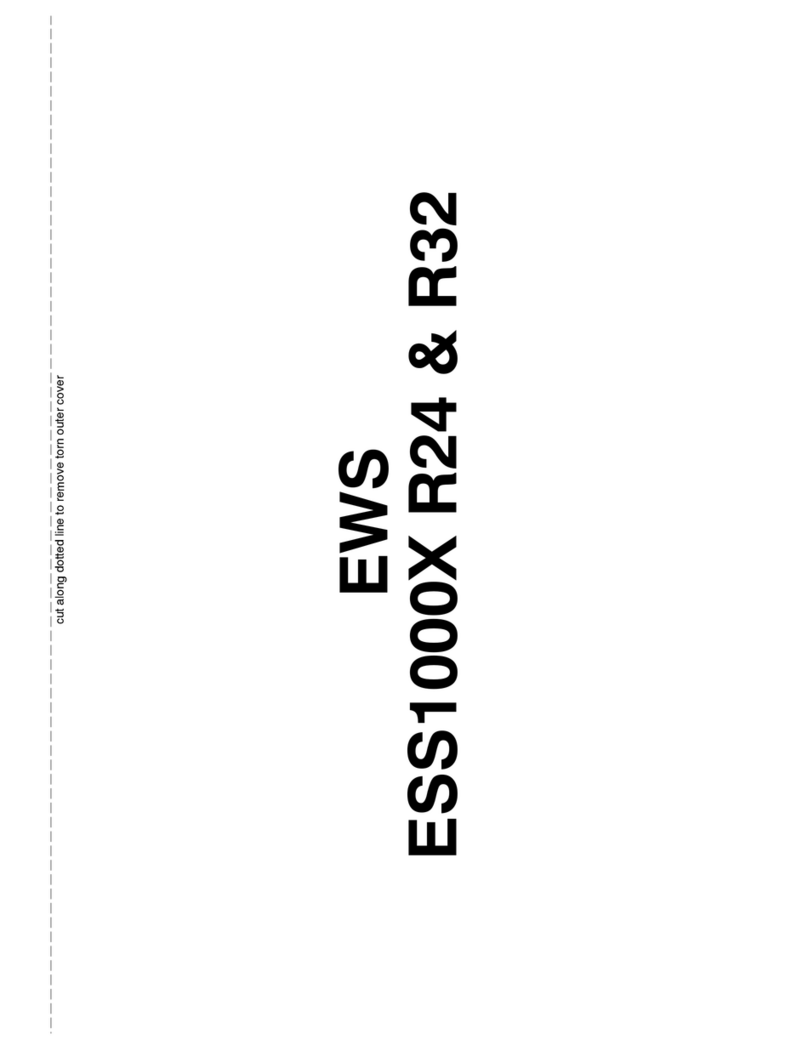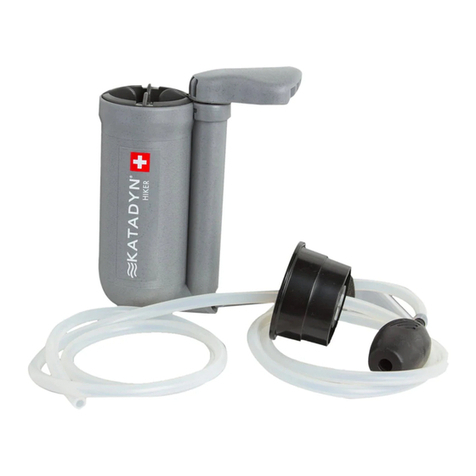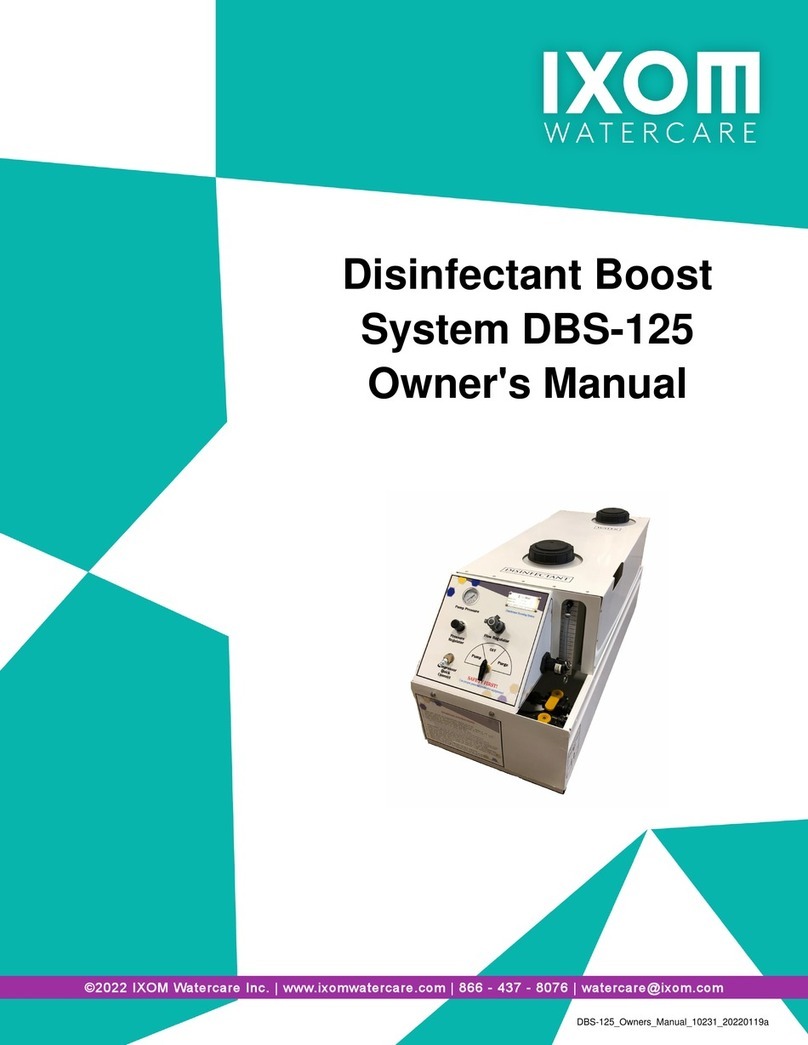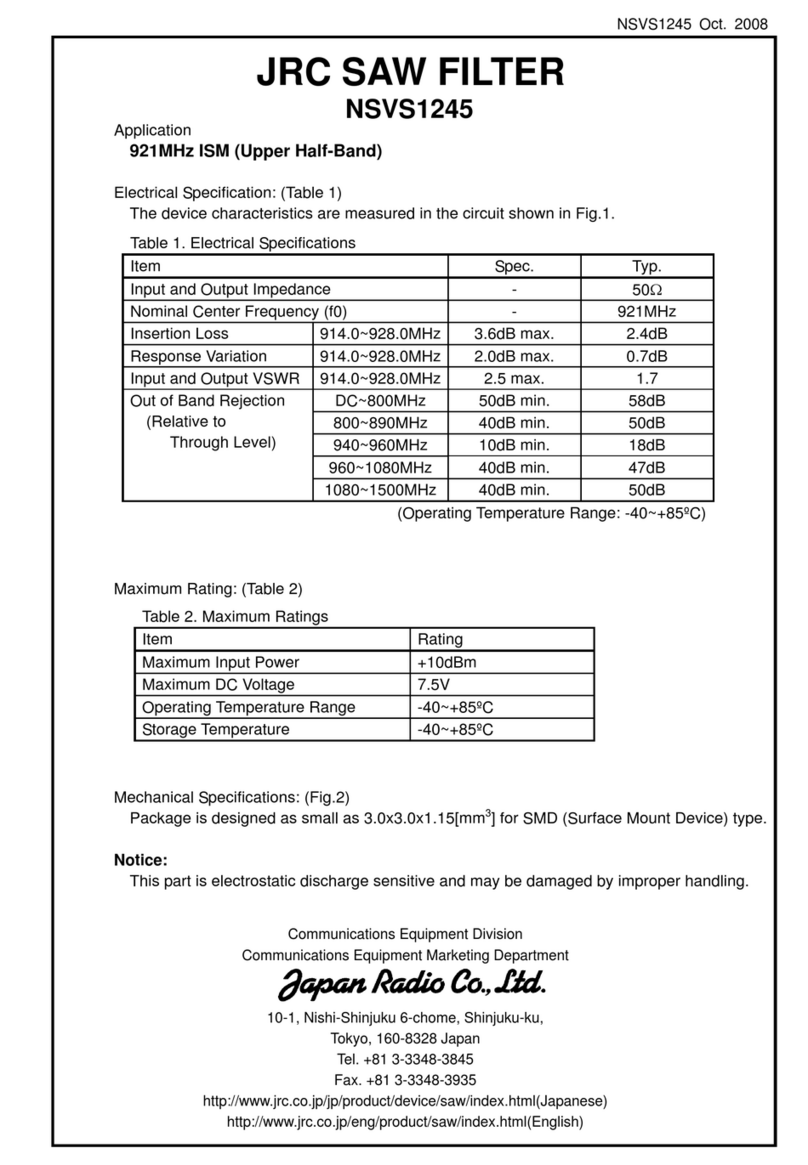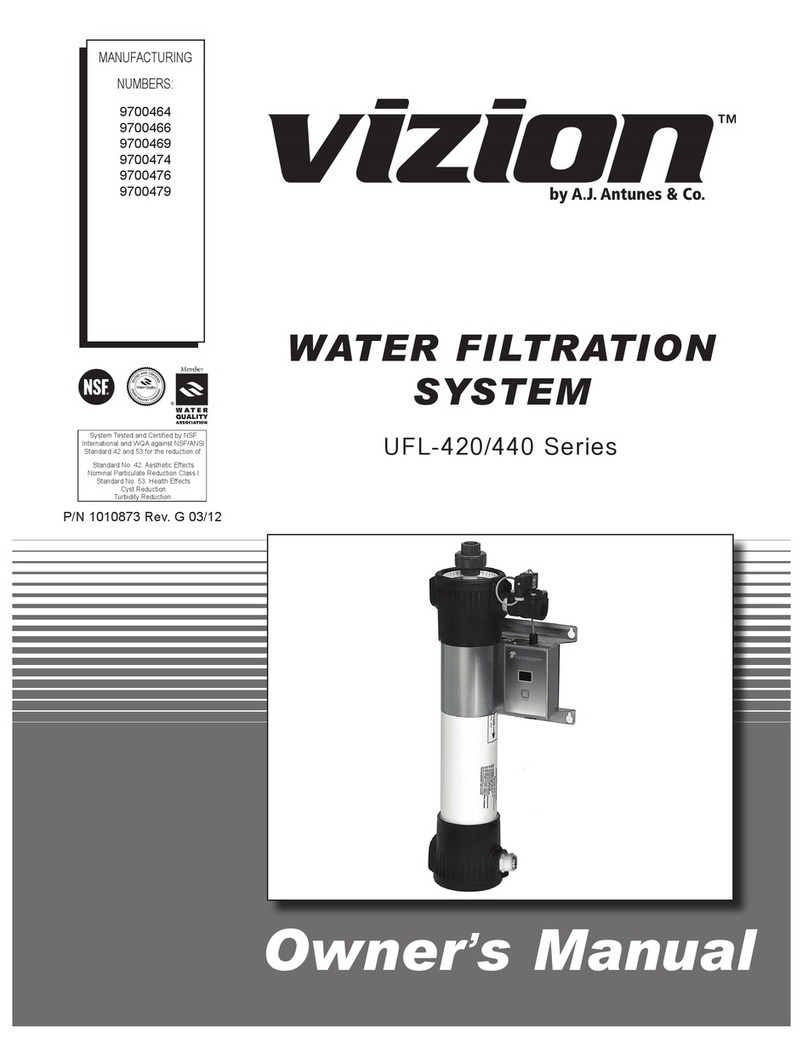Davco fuel pro 382 User manual

TABLE OF CONTENTS
How it Works . . . . . . . . . . . . . . . . 1
“SEEING IS BELIEVING”®. . . . . . . . . . . 2
• Important Safety Precautions . . . . . . . . 3
Fuel Pro 382 Dimensions . . . . . . . . . . . 4
Fluid Heater Installation . . . . . . . . . . . . 7
12 VDC and 24 VDC Electric Pre-heater Installation 8
Water in Fuel Sensor (WIF) Installation . . . . . . 9
Preventive Maintenance. . . . . . . . . . . . 10
Filter Change Procedure . . . . . . . . . . .11
Visual Diagnostics . . . . . . . . . . . . . . 12
Diagnostic Procedures . . . . . . . . . . . . 14
Check Valve Diagnostics . . . . . . . . . . .17
Service Parts . . . . . . . . . . . . . . . . 18
Warranty and Customer Service . . . . . . . .21
Technology, LLC
FUEL PRO ®382
TECHNICAL MANUAL
2012 ©DAVCO Technology, LLC.
Updated 09/05/2012
®
FOR UPDATED INFORMATION, VISIT WWW.DAVCO.COM

®
HOW IT WORKS
Fuel System Diagram
Figure 1
• Fuel from the tank enters the Fuel Processor body (suction side of the fuel system).
• Large contaminants and “free” water are separated from the fuel and remain in the body.
• Fuel rises into the clear cover.
• Contaminants and emulsified water are captured by the filter media.
• Fuel level rises to maintain a fuel path through the clean filter media with low restriction.
• Clean, water-free fuel exits the Fuel Processor and flows to the engine fuel injection system.
FUEL PRO®382
TECHNICAL MANUAL
Technology, LLC
DAVCO Technology, LLC P. O. Box 487 Saline, MI 48176 Call 800-328-2611 www.davco.com F1271 REV C
Updated 09/05/2012
1

®
• See when NOT to change the fuel filter.
• See the condition of the fuel. Seeing what collects on the filter media or what’s happening inside the clear cover
can help diagnose many fuel and mechanical conditions.
• “Filter on Top” configuration. Water and debris removed from the fuel falls to the lower chamber and stays away
from the filter media resulting in longer filter life.
• Built in protection when priming the fuel filter. Unfiltered fuel is kept on the “dirty” side of the filter media during
priming ensuring only clean fuel reaches the engine.
• Patented media. The “Best in Class” StrataPore™ media removes 98% of free and emulsified water over the life
of the filter. This far exceeds the performance of cellulose media.
“SEEING IS BELIEVING”®
When new, the fuel level in the filter will be very
low with minimal restriction. As the filter is used,
contaminants collect on the filter from the bottom up.
Fuel rises on the filter indicating remaining filter life.
Fuel level increases in clear cover. As contaminants
collect on the filter, the fuel rises to a non-contaminat-
ed section of the filter, providing optimal filtration while
maintaining lowest restriction.
Fuel level at filter wrap level. Even though the fuel
level is now more than half of the filter element, the
fuel is still flowing through clean media at minimal
restriction levels. The filter still has significant life
remaining.
The filter element is now completely covered by
fuel. At this point, all of the media’s surface area is
utilized. Restriction is increasing and the filter element
should be changed at the next scheduled mainte-
nance interval.
FUEL PRO®382
TECHNICAL MANUAL
Technology, LLC
DAVCO Technology, LLC P. O. Box 487 Saline, MI 48176 Call 800-328-2611 www.davco.com F1271 REV C
Updated 09/05/2012
2

®
• IMPORTANT SAFETY PRECAUTIONS
•General Safety Precautions
• Read all instructions before use to avoid injury
• To avoid serious injury or death, follow the safety information in this document
• Keep this manual
• Read all product safety labels
• Refer to appropriate regulations for environmental and workplace safety rules
•To prevent personal injury
• Scalding hazard: When diesel fuel is circulated through an operating engine, it can become very hot. Do not
allow fuel to come in contact with eyes or unprotected skin. Allow the engine and fuel to cool to ambient tem-
perature before replacing the fuel filter or performing service operations which could result in spillage of fuel
from the fuel system. If this is not possible, protective equipment (face shield, insulated hat, gloves, and apron)
must be worn.
• Fire Prevention: Heated fuel can form combustible vapor mixtures in the area around the fuel source. To
eliminate the potential for fire, keep open flames, sparks or other potential ignition sources away from the work
area. Do not smoke during filter replacement or service operations.
• Inhalation Precaution: Always perform engine or vehicle fuel system maintenance in a well ventilated area
that is kept free of bystanders.
• The ignition key must be in the off position, unless otherwise directed. To avoid unintentional engine startup,
use a lockout key and/or signage to alert personnel that work is being performed.
FUEL PRO®382
TECHNICAL MANUAL
Technology, LLC
DAVCO Technology, LLC P. O. Box 487 Saline, MI 48176 Call 800-328-2611 www.davco.com F1271 REV C
Updated 09/05/2012
3

®
FUEL PRO 382 DIMENSIONS
16.00 (406.4) MAX
3.46 (88.0)
6.75 (171.5) MAX
5.91 (150.0)
1/2" x 14
NPTF
FUEL INLET
1/2" x 14 NPTF
FUEL OUTLET Ø .43 (11.0)
(2 PLACES)
SERVICE HEIGHT
1.5 (38.1)
6.58 (167.1)
.50 (12.7)
3.9 (99.1)
3.28 (83.3)
FUEL
IN
BOTTOM
RIGHT SIDEFRONT
All dimensions are in inches (millimeters)
FUEL PRO®382
TECHNICAL MANUAL
Technology, LLC
DAVCO Technology, LLC P. O. Box 487 Saline, MI 48176 Call 800-328-2611 www.davco.com F1271 REV C
Updated 09/05/2012
4

®
INSTALLATION INSTRUCTIONS
Installation Location
The Fuel Pro must be installed between the fuel tank and
the fuel transfer pump. In some cases, the Fuel Pro can be
used as the only fuel filter in the system. This is generally
dependent on the engine model year. Consult the engine
manufacturer for their recommendation. If the Fuel Pro can
be used as a single filter, DAVCO offers a diverter cap to
replace the secondary filter. (See diverter cap installation
section)
Mounting the Fuel Pro
Mount the Fuel Pro keeping the following points in
mind:
• Do not install the Fuel Pro directly on the engine.
• Mount vertically with the cover and element pointing
up.
• Make sure there is enough top and side clearance for
the cover to be conveniently removed for filter replace-
ment.
• The Fuel Pro MUST be installed so that the Filter Ele-
ment is above the "FULL" level of the fuel tank.
•The ignition key must be in the off position, unless
otherwise directed. To avoid unintentional engine
startup, use a lockout key and/or signage to alert
personnel that work is being performed. Chock the
wheels.
Step 1: With the engine shut down and at ambient temper-
ature, close the fuel shutoff valve (if equipped) and place a
suitable container under the fuel filters.
Step 2: Remove the primary fuel filter element assembly,
sedimenter, and/or water separator. Drain the used ele-
ment and dispose of it in an environmentally responsible
manner, according to state and/or federal (EPA) recom-
mendations.
Fuel Line Routing
To minimize fuel system restriction, observe the follow-
ing guidelines when plumbing the fuel system:
• Keep the fuel line routing as smooth as possible with no
low-hanging loops which can trap water.
• Use 90° elbows only when necessary.
• If the fuel hoses are cut to length on the job, be sure that
the inner liner of the fuel hose is not cut by the fitting,
which can cause check valve performance issues. Make
sure hoses are clean and free of debris before installing.
• To avoid damaging the aluminum Fuel Pro body, do not
overtighten fuel lines or fuel line fittings.
Step 1: Route the fuel supply line from the pick up on the
fuel tank to the Fuel Pro inlet (labeled “Fuel In”).
Step 2: Route the fuel outlet line from the Fuel Pro outlet
(labeled “Fuel Out”) to the inlet of the fuel pump.
Priming the Fuel System
Step 1: Check to make sure the drain valve at the base of
the Fuel Pro is closed.
Step 2: Remove the vent cap from the top of the clear
cover. Fill the Fuel Pro full with clean fuel. Reinstall the vent
cap and tighten by hand only.
Step 3: Start the engine. When the lubrication system
reaches its normal operating pressure, increase engine
RPM to high idle for one to two minutes. After the air is
purged loosen the vent cap until the fuel level lowers to
just above the collar. Tighten the vent cap by hand only.
Step 4: Hand tighten the collar again while the engine is
running. To avoid damage, do not use tools to tighten the
collar.
Note: The clear filter cover will not fill completely during
engine operation. It will gradually fill over time and the fuel
level will rise as the filter becomes contaminated.
FUEL PRO®382
TECHNICAL MANUAL
Technology, LLC
DAVCO Technology, LLC P. O. Box 487 Saline, MI 48176 Call 800-328-2611 www.davco.com F1271 REV C
Updated 09/05/2012
5

®
Diverter Cap Installation
If a single fuel filter system is approved by the engine
manufacturer, the following steps are to be taken to install
a diverter cap properly.
Step 1: Select the required secondary filter head diverter
cap from those listed in Table 1. The required diverter cap
is determined by the size of the spin-on filter stud and the
filter sealing surface diameter.
Step 2: Drain and remove the secondary fuel filter element.
Step 3: Lightly lubricate the seal on the top of the diverter
cap with clean engine oil.
Step 4: Thread the adapter onto the secondary filter stud
and tighten by hand only.
Step 5: Install the “Do Not Remove” label on the diverter
cap.
Diverter Cap
Part Number
Required
Filter Head
Stud Size
Required
Filter Head
Seal ID
Required
Filter Head
Seal OD
101480 1"-14 2.475" 2.895"
101589 1"-14 3.225" 3.435"
101570 M16 x 1.5 2.475" 2.895"
101466 ¾"-16 2.475" 2.895"
101492 7/8" x 14 2.475" 2.895"
Table 1
INSTALLATION INSTRUCTIONS
FUEL PRO®382
TECHNICAL MANUAL
Technology, LLC
DAVCO Technology, LLC P. O. Box 487 Saline, MI 48176 Call 800-328-2611 www.davco.com F1271 REV C
Updated 09/05/2012
6

®
FLUID HEATER INSTALLATION
Figure 2 Figure 3
The engine return fuel heat and engine coolant heat options apply ONLY to the fluid heater base shown in Figures 2 and
3. If the bottom plate is flat with ½" NPT ports, only the electric pre-heater can be used. Contact DAVCO Customer Ser-
vice to obtain the appropriate bottom plate.
Engine Coolant Heat
To use engine coolant as the Fuel Pro heating fluid, con-
nect a hose (5/8" silicon heater hose) from the high pres-
sure side of the engine coolant system to the Fuel Pro
heater base. Either heater port will work as an inlet. Route
another hose from the heater base to a low pressure port
in the coolant system. DO NOT route into the cab heater
system. (See Figure 2)
Engine Return Fuel Heat
High flow and high temperature return fuel engines can
use the return fuel as the heating fluid for the Fuel Pro.
Route the return fuel line from the engine into the heater
base of the Fuel Pro. Either heater port will work as an in-
let. Connect a second fuel return line from the heater base
to the fuel tank return port.(See Figure 3)
inlet or outlet ports
coolant
transfer pump
fuel tank
Fuel Pro
inlet or outlet ports
return fuel
transfer pump
Fuel Pro
fuel tank
FUEL PRO®382
TECHNICAL MANUAL
Technology, LLC
DAVCO Technology, LLC P. O. Box 487 Saline, MI 48176 Call 800-328-2611 www.davco.com F1271 REV C
Updated 09/05/2012
7

®
The Fuel Pro 382 12 VDC or 24 VDC electric pre-heater is
installed in the processor base as shown in Figure 4.
Figure 4
Step 1: Drain all the fuel from the Fuel Pro. The fuel can
be reused after the pre-heater is installed. If the fuel is not
reused, dispose of it in an environmentally safe way.
Step 2: Remove the pipe plug in the Fuel Pro base plate.
Step 3: Apply liquid thread sealant to the pre-heater
threads and install into the Fuel Pro base. Tighten to 15-30
ft-lbs.
Step 4: Connect the chassis harness and wire.
• For 12 VDC or 24 VDC without a relay, refer to Figure 5.
• For 12 VDC or 24 VDC with a relay, refer to
Figure6.
• If the keyed circuit will not handle a minimum of 20
amps, use a relay.
• Provide proper (20 amp fuse) electrical protection for
source voltage supplied to the pre-heater.
Step 5: Remove the vent cap from the top of the clear
cover. Pour fuel into the Fuel Pro to one inch below the
top of the filter element. Reinstall the vent cap and hand
tighten.
Step 6: Start the engine. When the lubrication system
reaches its normal operating pressure, increase engine
speed to high idle for one to two minutes. After the air is
purged, loosen the vent cap until the fuel level drops to
just above the collar. Tighten the vent cap by hand only.
Heater element
FUEL PRO
+
20 A Switch
GND GND
Key Controlled Circuit
Fuse*
Battery
Pre-heater Wiring without Relay
*24 VDC pre-heaters require a 15 A fuse.
Figure 5
+
GND
Relay
Key Controlled Circuit
GND
GND
20 A
Fuse*
Battery
FUEL PRO
Heater element
Pre-heater Wiring with Relay
*12 VDC pre-heaters require a 20 AMP fuse. If the keyed circuit will not
handle a minimum of 20 amps, use a relay.
Figure 6
12 VDC AND 24 VDC ELECTRIC PRE-HEATER INSTALLATION
FUEL PRO®382
TECHNICAL MANUAL
Technology, LLC
DAVCO Technology, LLC P. O. Box 487 Saline, MI 48176 Call 800-328-2611 www.davco.com F1271 REV C
Updated 09/05/2012
8

®
Step 1: Remove the ½"-20 WIF plug in the bottom of the
Fuel Pro.
Step 2: Install the WIF Probe (See Service Parts Page
for P/N) into the bottom of the Fuel Pro. Torque to 20-24
in-lbs.
Step 3: Install the WIF wiring harness (P/N 102600) on
WIF Probe. The harness has the following connections:
black ground lead with a 3/8" diameter ring terminal and
a green WIF wire.
Step 4: Drill ½" hole in the instrument or control panel
where the WIF indicator light is to be located.
Step 5: Connect the black ground wire from the WIF
indicator light to a ground source. Attach additional black
wire as needed.
Step 6: Install the WIF indicator light by pressing firmly
into the drilled hole.
Step 7: Connect the black ground lead with a 3/8" diam-
eter loop end on the WIF wiring harness to the ground
source near the Fuel Pro (if applicable).
Step 8: Connect the green signal wire on WIF wiring
harness to green signal wire on WIF indicator light. Use
additional green wire as needed.
Step 9: Locate 12 VDC or 24 VDC key controlled on
power source. Install a red wire from the power source to
the red wire on WIF indicator light. Add a 1 amp in-line
fuse (not included).
Note: Use appropriate connectors to attach the wires. To
test the WIF indicator light, pour water into the body of
the Fuel Pro until it covers the WIF probe. The WIF indica-
tor light should illuminate.
WATER IN FUEL SENSOR (WIF) INSTALLATION
CHASSIS
GROUND
FUEL
WATER
PROBE
GREEN
CHASSIS
GROUND
BLACK
RED
TO ANY KEYED
12 OR 24 VDC SOURCE
(Recommended fuse: 500ma for 12 VDC. Do not exceed 1 A.)
WATER-IN-FUEL
(WIF)
WARNING LIGHT
FUEL PRO®382
TECHNICAL MANUAL
Technology, LLC
DAVCO Technology, LLC P. O. Box 487 Saline, MI 48176 Call 800-328-2611 www.davco.com F1271 REV C
Updated 09/05/2012
9

®
PREVENTIVE MAINTENANCE
• Weekly – Drain water
• Turn off the engine and open the vent cap.
• Place a suitable eight ounce, plastic or metal container under the drain valve at the base of the Fuel
Pro and open the valve.
• Water will flow into the container. When fuel begins to flow out the drain, close the drain valve. Drain
the least amount of fuel as possible.
• Hand-tighten the vent cap.
• Start the engine. Raise the RPM for one minute to purge the air from the system.
• Every filter change
• Change the cover and vent cap o-rings (included with the service filter kit).
• Every 12 months
• Check all electrical connections for corrosion. Check all fuel fittings for leaks.
• Seasonal Maintenance:
• Extreme winter or salt corrosion environments may require lubrication of the collar threads with anti-
seize lubricant every 180 days.
FUEL PRO®382
TECHNICAL MANUAL
Technology, LLC
DAVCO Technology, LLC P. O. Box 487 Saline, MI 48176 Call 800-328-2611 www.davco.com F1271 REV C
Updated 09/05/2012
10

®
FILTER CHANGE PROCEDURE
For filter selection visit www.davco.com/parts.html (Parts
And Cross Reference) for the correct filter for your applica-
tion or call DAVCO Customer Service at 800-328-2611.
Step 1: Remove the vent cap and open the drain valve to
drain the fuel below the collar level.
Step 2: Remove the collar (using the DAVCO collar
wrench) then remove the clear cover.
Step 3: Remove the filter, cover and vent cap seals.
Dispose of the filter and the seals properly.
Step 4: Using a clean shop rag, clean the cover, the collar
and threads on the Fuel Pro body.
Step 5: Install a new filter, cover seal and vent cap seal.
Step 6: Reinstall the clear cover and collar. Hand tighten
the collar.
Step 7: Prime the unit by filling the clear cover with clean
diesel fuel until it reaches the top of the filter.
Step 8: Install the vent cap. Hand tighten only.
Step 9: Start the engine and run for one minute. Slowly
open the vent cap and allow the fuel to drop to about one
inch above the collar.
Step 10: Close the vent cap. Hand tighten only. It is
normal for the fuel level to vary after the initial start-up and
during engine operation. Filter performance is not affected.
Service Wrench Information
• The DAVCO Fuel Pro vent cap and collar are
designed to be removed with a DAVCO wrench.
• Vent caps and/or collars damaged as a result of
not using the DAVCO wrench will not be covered
under warranty. Wrench is for removal ONLY.
Description P/N
Metal Collar/Vent Cap Wrench 380134
Composite Collar/Vent Cap Wrench 382002
Metal Collar/Vent Cap Wrench
Composite Collar/Vent Cap Wrench
FUEL PRO®382
TECHNICAL MANUAL
Technology, LLC
DAVCO Technology, LLC P. O. Box 487 Saline, MI 48176 Call 800-328-2611 www.davco.com F1271 REV C
Updated 09/05/2012
11

®
Fuel level is not at the top of the fuel
filter.
ÎNormal - Do not change the filter.
Fuel level is at the top of the filter. Low
power.
ÎChange the filter at the first available
opportunity.
Fuel level is at the top of the filter and
appears to be full of wax.
ÎChange the filter - Run the engine for
a minimum of 25 minutes at idle. Do not
run at full RPM.
There is a power complaint and the fuel
level is below the collar.
ÎCheck for a missing grommet at the
lower end of the filter or missing/broken
spring at top of filter.
Bubbles are seen flowing in with the
fuel.
ÎCheck all fittings and lines from the
fuel tank to the fuel processor. Check
lower and upper collar o-rings.
Water is noticed in the cover.
ÎDrain the water. If engine coolant is
visible, follow proper engine pressure
testing procedures to determine root
cause.
Fuel drains back to the fuel tank when
changing the fuel filter or draining sepa-
rator.
ÎRemove the check valve assembly.
Clean or replace and retest. Check air
leaks in the fuel system.
No engine coolant flow to the Fuel Pro
heater.
ÎCheck for closed cutoff valves at
the coolant lines to the fuel processor.
Make sure the cab heater valve is open.
VISUAL DIAGNOSTICS
FUEL PRO®382
TECHNICAL MANUAL
Technology, LLC
DAVCO Technology, LLC P. O. Box 487 Saline, MI 48176 Call 800-328-2611 www.davco.com F1271 REV C
Updated 09/05/2012
12

®
Air Bubbles (will affect engine performance)
Air bubbles are caused by any air leak on the vacuum (suc-
tion) side of the fuel system from the fuel tank pick-up to,
and including, the lift pump. (See Figure 7)
If there is an air leak in the fuel system, air bubbles will
be present in the clear cover of the Fuel Pro. Follow test
procedures outlined in "Troubleshooting" for air leak diag-
nostics.
If there are no bubbles present in the Fuel Pro cover and
the engine continues to run rough, lopes or has a loss
of power, there may be an air leak between the Fuel Pro
outlet port and lift pump inlet. This type of air bubble can
be seen if a sight tube is installed at the lift pump inlet. Air
bubbles may also be visible in the fuel return (spill) hose
out of the fuel gallery. These leaks are easily eliminated by
checking and torquing the fuel fittings in the area of the
leak.
If there are no air leak symptoms, but bubbles are pres-
ent in a sight tube at the fuel lift pump inlet, they are most
likely vapor bubbles.
Note: A quick procedure to determine if the air leak is
between the fuel tank and the Fuel Pro is to remove the
Fuel Pro inlet hose and route a new hose from the Fuel Pro
inlet into a container of fuel or the fuel tank fill cap opening.
Start the engine and check for bubbles.
Vapor Bubbles (will not affect engine perfor-
mance)
All diesel fuel has some level of entrained air caused by the
natural splashing that occurs in the fuel tank during normal
vehicle or equipment operation. Vapor bubbles develop in
the Fuel Pro because the pressure inside the Fuel Pro is
lower than the atmospheric pressure in the fuel tank. Vapor
bubbles can vary from champagne size up to ¼" in diam-
eter. They may increase in size or volume as engine RPM
increases. The lower pressure draws the entrained air/va-
por out of the fuel and these bubbles will be visible as the
fuel exits the Fuel Pro. (See Figure 8)
As the fuel enters the lift pump, it is pressurized and the
bubbles are compressed back into the fuel. There will be
no bubbles on the fuel return side of the system. (See Fig-
ure 8). These vapor bubbles will not affect the performance
of the engine.
There is no diagnostic or repair procedure required for
vapor bubbles. Vapor bubbles do not cause performance
issues and will not be present after the lift pump.
There are two kinds of bubbles that may be visible at the fuel pump inlet of a diesel fuel system. The bubbles can be
characterized as either air bubbles or vapor bubbles.
VISUAL DIAGNOSTICS
L
Y
FI
FUE PRO
OR OTHER
PRIMAR
LTER
FUE RETURN
ENGINE
LIF PUM
AIR
BUBBLES
L
T P
Figure 7
VAPOR
BUBBLES
L
Y
FI
FUE PRO
OR OTHER
PRIMAR
LTER
FUE RETURN
ENGINE
LIF PUM
L
T P
Figure 8
FUEL PRO®382
TECHNICAL MANUAL
Technology, LLC
DAVCO Technology, LLC P. O. Box 487 Saline, MI 48176 Call 800-328-2611 www.davco.com F1271 REV C
Updated 09/05/2012
13

®
Air Leaks
Note: Every Fuel Pro is factory tested for leaks and is
identified with a traceable number prior to shipment. Most
field issues associated with leaks are related to loose
fittings. These leaks are easily eliminated by checking
and torquing the fuel fittings in the area of the leak. Some
fittings may also require the application of liquid Teflon
sealer.
Note: All suction side fuel filters experience bubbles. It
is normal to see champagne size bubbles in the Fuel Pro
cover, at the Fuel Pro outlet or at the lift pump.
IN ORDER TO RETURN A FUEL PRO FOR EVALU-
ATION, THE FOLLOWING PROCEDURES/TESTS
MUST BE COMPLETED BEFORE REQUESTING A
DAVCO RGA (RETURN GOODS AUTHORIZATION)
NUMBER.
I. Air Leak: Air bubbles will be visible in the clear cover
of the Fuel Pro if the leak originates between the fuel
tank up and the fuel filter. The following is a quick test
to isolate the air leak source.
A. Bubbles Visible: Remove the Fuel Pro inlet
hose.
i. Install a jumper hose from the Fuel Pro to
the fuel tank (through the fill cap) or to a
container of fuel.
ii. Start the engine. If this eliminates the air
bubbles, the air source is at the fuel tank
fittings or hose connections.
1. Tighten all fittings and connectors
2. Retest
iii. If air bubbles persist, the air source is on
the Fuel Pro side of the system:
1. Tighten all fittings on the Fuel Pro .
2. Hand tighten the top collar.
3. If the drain valve is suspected, install
a plug in place of the drain valve (for
test purposes only).
iv. If air bubbles continue to persist, test as
follows:
1. Remove the Fuel Pro from the chas-
sis.
2. Plug the fuel outlet port. Do not
remove filter, cover/collar, vent cap,
drain valve and/or check valve. If the
Fuel Pro is equipped with a pre-heat-
er, do not remove the pre-heater.
3. Apply 15 PSI of air pressure at the
fuel inlet. Immerse the Fuel Pro in a
tank of water and look for air bub-
bles.
4. Correct the source of the air leak and
retest.
B. Bubbles Not Visible: If there are symptoms of
sucking air (indicated by engine loping/rough
running performance/power loss, etc.) and
there are no bubbles in the clear cover, the air
leak is either at the Fuel Pro outlet fitting, vent
cap o-ring, the lift pump inlet connection, or the
fuel hose/connections to the lift pump. Inspect
and tighten fittings as needed.
II. Excessive Restriction: If the fuel level is at the top
of the filter, replace the fuel filter. The Fuel Pro will
not cause excess system restriction if the fuel level
is below the top of the filter. The only exception is if
the grommet is not installed in the bottom of the filter
element.
III. Loss of Prime: When air is introduced into the fuel
system, (i.e. draining water from the Fuel Pro or when
replacing the fuel filter) a check valve is needed to
keep the fuel system primed from the Fuel Pro back
to the fuel tank. A check valve is standard with every
Fuel Pro
A. To test for proper check valve operation,
remove the fuel inlet hose and open the vent
cap. Fuel should not flow out of the Fuel Pro ,
although a slight seepage of fuel is normal.
B. If fuel drains back to the fuel tank, remove the
check valve assembly at the fuel inlet fitting.
Disassemble the check valve assembly. Clean
and inspect. Replace the assembly if any cuts,
grooves or nicks are evident in the ball or body
seat. Reinstall the check valve assembly.
DIAGNOSTIC PROCEDURES
FUEL PRO®382
TECHNICAL MANUAL
Technology, LLC
DAVCO Technology, LLC P. O. Box 487 Saline, MI 48176 Call 800-328-2611 www.davco.com F1271 REV C
Updated 09/05/2012
14

®
Fluid Heater Thermovalve Test
Step 1: Drain the Fuel Pro completely.
Step 2: Remove the fluid hoses going to the bottom plate.
These will either be engine coolant hoses or return fuel
hoses. Engine coolant hoses will have to be plugged when
removing them from the Fuel Pro.
Step 3: Remove the bottom plate.
Step 4: While looking into the fluid port of the bottom plate
(see Figure 9) flow cold water over the thermovalve for
30 seconds, then run hot water over the thermovalve and
determine if the thermovalve spool is opening and closing.
Step 5: Replace with a new bottom plate seal and install
the bottom plate onto the Fuel Pro.
Note: There are two styles of bottom plates.
• Torque the collar version to 50 to 60 ft-lbs (the use of
2-3 drops of Loctite 406 is recommended to secure the
bottom collar). Use seal P/N 101994.
• Torque the bolts on the bolt-on version bottom plate to
10 ft-lbs. Use seal P/N 910005.
Step 6: Reconnect the fluid hoses to the bottom of the
Fuel Pro.
Step 7: Fill the Fuel Pro with fuel and restart the engine.
Port to view
thermovalve
spool
Thermovalve
Figure 9
Electric Pre-Heater and Thermoswitch
Tests
Equipment Needed:
• A precision low resistance Ohm Meter capable of mea-
suring 1/10th Ohm or less is recommended.
• Current Flow Meter (Clamp-on type for DC current).
• Ice, dry-ice, CO2or some means of chilling the thermo-
switch.
• A flameless source of heat. Infrared heat lamp, etc. (a
Vortex tube is a good tool to heat and cool for testing).
•DO NOT USE a test light that has a wire probe for
any of these tests. If the insulation of the wiring is
punctured, moisture and road salt can penetrate into
the wires creating a corrosion issue and potential
failure.
There are various configurations of electric pre-heaters and
thermoswitches available for the Fuel Pro. These include
12 VDC pre-heaters, 24 VDC pre-heaters, 120 VAC pre-
heaters, thermoswitch, and combination pre-heater ther-
moswitch. The voltage and wattage ratings are stamped
either on the sheath or the hex of each component for
identification.
If it is necessary to remove the fuel from the fuel/water
separator:
• Shut off the engine and set the parking brake.
• Attach a length of hose to the drain valve and into a
container.
• Loosen the vent cap on top of the clear housing, and
open the drain valve to drain the fuel into the receptacle.
• When the fuel is drained, close the drain valve.
Pre-heater Test
Step 1: Disconnect the pre-heater from the harness.
Step 2: Connect the Ohm meter leads to the pins of the
pre-heater (connect to a pin and the bushing for pre-
heaters with one pin).
Step 3: Using the Table 2, read the value of the resistance
and determine if the pre-heater is within the acceptable
range.
DIAGNOSTIC PROCEDURES
FUEL PRO®382
TECHNICAL MANUAL
Technology, LLC
DAVCO Technology, LLC P. O. Box 487 Saline, MI 48176 Call 800-328-2611 www.davco.com F1271 REV C
Updated 09/05/2012
15

®
Electric
Pre-heater Watts Resistance Range
in Ohms
12 VDC (two pin) 250 W 0.6 to 0.8
12 VDC (single pin) 250 W 0.6 to 0.8
12 VDC (single pin) 150 W 0.8 to 1.1
12 VDC (two pin) 150 W 0.8 to 1.1
24 VDC (two pin) 250 W 2 to 2.5
24 VDC (single pin) 250 W 1.8 to 2.3
24 VDC (single pin) 150 W 3.6 to 4.1
120 VAC 75 W 173 TO 203
120 VAC 37 W 369 TO 411
Table 2
12 VDC Thermoswitch Test
Step 1: Disconnect the thermoswitch harness (see Figure
10).
Step 2: Connect the Ohm meter leads to the pins of the
thermoswitch.
Figure 10
Note: This test requires the thermoswitch to be below 40°
F. (Use one of the cooling sources listed under "Equipment
Needed".) The resistance should be less than 0.1 Ohm.
Step 3: Using one of the heat sources listed under "Equip-
ment Needed", raise the temperature above 60° F. The
resistance should be more than 10M Ohms.
Step 4: Prime the unit by filling the clear cover with clean
diesel fuel until it reaches the top of the filter.
Step 5: Install the vent cap. Hand tighten only.
Step 6: Start the engine and run for one minute. Slowly
open the vent cap and allow the fuel to drop to about one
inch above the collar. Close the vent cap. Hand tighten
only.
DIAGNOSTIC PROCEDURES
FUEL PRO®382
TECHNICAL MANUAL
Technology, LLC
DAVCO Technology, LLC P. O. Box 487 Saline, MI 48176 Call 800-328-2611 www.davco.com F1271 REV C
Updated 09/05/2012
16

®
CHECK VALVE DIAGNOSTICS
To test for proper check valve operation, remove the fuel
inlet hose and open the vent cap. Fuel should not flow out
of the Fuel Pro, although a slight seepage of fuel is normal.
If fuel drains back to the fuel tank, remove the check valve
assembly at the fuel inlet fitting.
Step 1: Use a back-up wrench to hold the check valve
body and remove the fuel hose from the inlet of the Fuel
Pro.
Step 2: Remove and disassemble the check valve assem-
bly.
Step 3: Clean and inspect the check valve body. Replace
the check valve body if any cuts, grooves or nicks are
evident or if the ball seat is not smooth.
Step 4: Inspect the check valve spring and spring retainer.
If the spring or spring retainer is broken or if the check ball
has groves, nicks or is out of round, replace with a check
valve service kit. Otherwise, clean and reassemble the
check valve assembly.
Note: The spring retainer snaps into a groove in the check-
valve body.
Step 5: Replace the check valve assembly into the body
and torque to 44-60 ft-lb.
Step 6: . Connect the fuel inlet hose, using liquid or paste
type thread sealant.
Step 7: Prime the fuel system, start the engine and check
for any fuel leaks.
Check Valve Body Check Valve Service Kit
P/N 090037 P/N 101132
FUEL PRO®382
TECHNICAL MANUAL
Technology, LLC
DAVCO Technology, LLC P. O. Box 487 Saline, MI 48176 Call 800-328-2611 www.davco.com F1271 REV C
Updated 09/05/2012
17

®
SERVICE PARTS
Service Kits
Description Contents Part Number
Vent cap ser-
vice kit
Vent cap and
Vent cap
O-ring
380043
O-ring
service kit
Vent cap and Cover
O-rings 380072
Check valve
service kit
Retainer, spring and
ball (does not include
the check valve body)
101132
Check Valve Service Kit: P/N 101132
Check Valve Body
Service Parts
Description Part Number
Collar 102425
Clear Cover 102420
Spring 380056
Filter Element visit www.davco.com/parts.html
for filter ordering information.
Drain Valve 102008
Electric Pre-heaters visit www.davco.com, Form F1263
WIF See Page 20
Check valve body 090037
Spin-on stud
13/16"-12
(Yellow Zinc)
320620
Heated
Drain Valve
Drain Valve
Check Valve
Service Kit
Check Valve
Service Kit
Check Valve Body
Spin-on Stud
OR
O-Ring Kit
(part no. 380072)
Includes a vent cap seal
and a cover seal.
Vent Cap Kit
(part no. 240023DAV)
Includes Vent Cap
with vent cap seal installed.
Spring
Filter
Collar
DAVCO Wrenches
Description Part Number
Metal Col-
lar/Vent Cap
Wrench
380134
Composite
Collar/Vent
Cap Wrench
382002
FUEL PRO®382
TECHNICAL MANUAL
Technology, LLC
DAVCO Technology, LLC P. O. Box 487 Saline, MI 48176 Call 800-328-2611 www.davco.com F1271 REV C
Updated 09/05/2012
18
Visit www.davco.com for OEM service part number listing.

®
SERVICE PARTS
Bottom Plate - Service Kits and Parts
Description Part Number
Seal (Bottom Collar) 101994
Seal (Bolt-On) 910005
Unheated Bottom Plate (Bottom
Collar) 382006SVC
Fluid Heated Bottom Plate
(Bottom Collar) 382015SVC
Unheated Bottom Plate (Bolt-On) 382027SVCB
Bottom Plate Upgrade Includes:
Radiator o-rings (2)
Thermo-Valve Assembly
Bottom plate seal (square cut)
Spool assembly
Bottom plate plug w/o-ring
382029SVCB Standard
382029SVCBE With ESOC port
382029-5SDAV With ½-20 WIF port and 3/8" Fluid
Port
382029-14DAV With ½-20 WIF, 3/8" Fluid Ports and
Heater Port
382029NAV Navistar Bottom Plate with 9/16"
Fluid Heat, Heater and WIF ports
FUEL PRO®382
TECHNICAL MANUAL
Technology, LLC
DAVCO Technology, LLC P. O. Box 487 Saline, MI 48176 Call 800-328-2611 www.davco.com F1271 REV C
Updated 09/05/2012
19
Visit www.davco.com for OEM service part number listing.
Other manuals for fuel pro 382
1
Table of contents
Other Davco Water Filtration System manuals
